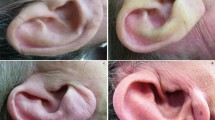Abstract
Acute myocardial infarction is one of the leading causes of cardiovascular disease mortality in both men and women. Chest pain, which is often described as chest pressure, tightness, or a squeezing sensation, is the most frequent symptom in patients presenting with acute myocardial infarction. Although the diagnosis of acute myocardial infarction is often based on typical changes on a surface electrocardiogram and on changes in cardiac biomarkers, there is a need to better recognize and understand the impact of sex on symptoms among patients presenting with acute coronary syndrome or acute myocardial infarction. We briefly review the pathophysiology of ischemic symptoms, discuss potential mechanisms for variation in ischemic symptoms by sex, and summarize recent publications that have addressed sex differences in ischemic symptoms.
Similar content being viewed by others
References
Papers of particular interest, published recently, have been highlighted as: •• Of major importance
Go AS, Mozaffarian D, Roger VL, et al. Heart disease and stroke statistics-2014 update: a report from the American Heart Association. Circulation. 2014;129(3):e28–292.
Canto JG, Rogers WJ, Goldberg RJ, et al. Association of age and sex with myocardial infarction symptom presentation and in-hospital mortality. JAMA. 2012;307(8):813–22.
Gupta A, Wang Y, Spertus JA, et al. Trends in acute myocardial infarction in young patients and differences by sex and race, 2001 to 2010. J Am Coll Cardiol. 2014;64(4):337–45.
Thygesen K, Alpert JS, Jaffe AS, et al. Third universal definition of myocardial infarction. J Am Coll Cardiol. 2012;60(16):1581–98.
Nawar EW, Niska RW, Xu J. National hospital ambulatory medical care survey, emergency department summary. Adv Data. 2005;2007(386):1–32.
Yeh RW, Sidney S, Chandra M, et al. Population trends in the incidence and outcomes of acute myocardial infarction. N Engl J Med. 2010;362(23):2155–65.
Meischke H, Larsen MP, Eisenberg MS. Gender differences in reported symptoms for acute myocardial infarction: impact on prehospital delay time interval. Am J Emerg Med. 1998;16(4):363–6.
Chen W, Woods SL, Puntillo KA. Gender differences in symptoms associated with acute myocardial infarction: a review of the research. Heart Lung J Crit Care. 2005;34(4):240–7.
Shin JY, Martin R, Suls J. Meta-analytic evaluation of gender differences and symptom measurement strategies in acute coronary syndromes. Heart Lung J Crit Care. 2010;39(4):283–95.
Gibbons RJ, Balady GJ, Bricker JT, et al. ACC/AHA 2002 guideline update for exercise testing: summary article: a report of the American College of Cardiology/American Heart Association Task Force on Practice Guidelines (Committee to Update the 1997 Exercise Testing Guidelines). Circulation. 2002;106(14):1883–92.
Arslanian-Engoren C, Engoren M. Physiological and anatomical bases for sex differences in pain and nausea as presenting symptoms of acute coronary syndromes. Heart Lung J Crit Care. 2010;39(5):386–93.
Kreatsoulas C, Shannon HS, Giacomini M, et al. Reconstructing angina: cardiac symptoms are the same in women and men. JAMA Intern Med. 2013;173(9):829–31. This study shows that there are no differences in anginal symptoms between men and women with stable CAD.
Mackay MH, Ratner PA, Johnson JL, et al. Gender differences in symptoms of myocardial ischaemia. Eur Heart J. 2011;32(24):3107–14.
Tamura A, Naono S, Torigoe K, et al. Gender differences in symptoms during 60-second balloon occlusion of the coronary artery. Am J Cardiol. 2013;111(12):1751–4.
Devon HA, Rosenfeld A, Steffen AD, et al. Sensitivity, specificity, and sex differences in symptoms reported on the 13-item acute coronary syndrome checklist. J Am Heart Assoc. 2014;3(2):e000586. This is a prospective multi-center study that sought to determine the influence of gender on symptoms during ACS.
Rubini Gimenez M, Reiter M, Twerenbold R, et al. Sex-specific chest pain characteristics in the early diagnosis of acute myocardial infarction. JAMA Intern Med. 2014;174(2):241–9. This prospective study shows that differences in chest pain characteristics by gender are small and are not powerful enough to be used clinically in the diagnosis of AMI.
Khan NA, Daskalopoulou SS, Karp I, et al. Sex differences in acute coronary syndrome symptom presentation in young patients. JAMA Intern Med. 2013;173(20):1863–71.
Eastwood JA, Johnson BD, Rutledge T, et al. Anginal symptoms, coronary artery disease, and adverse outcomes in Black and White women: the NHLBI-sponsored Women’s Ischemia Syndrome Evaluation (WISE) study. J Women’s Health. 2013;22(9):724–32.
Reis SE, Holubkov R, Conrad Smith AJ, et al. Coronary microvascular dysfunction is highly prevalent in women with chest pain in the absence of coronary artery disease: results from the NHLBI WISE study. Am Heart J. 2001;141(5):735–41.
Marroquin OC, Holubkov R, Edmundowicz D, et al. Heterogeneity of microvascular dysfunction in women with chest pain not attributable to coronary artery disease: implications for clinical practice. Am Heart J. 2003;145(4):628–35.
Murthy VL, Naya M, Taqueti VR, et al. Effects of sex on coronary microvascular dysfunction and cardiac outcomes. Circulation. 2014;129(24):2518–27.
Burg MM, Edmondson D, Shimbo D, et al. The ‘perfect storm’ and acute coronary syndrome onset: do psychosocial factors play a role? Prog Cardiovasc Dis. 2013;55(6):601–10.
Compliance with Ethics Guidelines
Conflict of Interest
Garima Arora and Vera Bittner declare that they have no conflict of interest.
Human and Animal Rights and Informed Consent
This article does not contain any studies with human or animal subjects performed by any of the authors.
Author information
Authors and Affiliations
Corresponding author
Additional information
This article is part of the Topical Collection on Ischemic Heart Disease
Rights and permissions
About this article
Cite this article
Arora, G., Bittner, V. Chest Pain Characteristics and Gender in the Early Diagnosis of Acute Myocardial Infarction. Curr Cardiol Rep 17, 5 (2015). https://doi.org/10.1007/s11886-014-0557-5
Published:
DOI: https://doi.org/10.1007/s11886-014-0557-5




